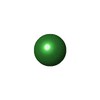[English] 日本語
 Yorodumi
Yorodumi- PDB-1f9z: CRYSTAL STRUCTURE OF THE NI(II)-BOUND GLYOXALASE I FROM ESCHERICH... -
+ Open data
Open data
- Basic information
Basic information
| Entry | Database: PDB / ID: 1f9z | ||||||
|---|---|---|---|---|---|---|---|
| Title | CRYSTAL STRUCTURE OF THE NI(II)-BOUND GLYOXALASE I FROM ESCHERICHIA COLI | ||||||
 Components Components | GLYOXALASE I | ||||||
 Keywords Keywords | LYASE / Beta-Alpha-Beta-Beta-Beta motif / Protein-Ni(II) complex / homodimer | ||||||
| Function / homology |  Function and homology information Function and homology informationlactoylglutathione lyase / lactoylglutathione lyase activity / : / nickel cation binding / response to toxic substance / protein homodimerization activity / cytosol / cytoplasm Similarity search - Function | ||||||
| Biological species |  | ||||||
| Method |  X-RAY DIFFRACTION / X-RAY DIFFRACTION /  SYNCHROTRON / Resolution: 1.5 Å SYNCHROTRON / Resolution: 1.5 Å | ||||||
 Authors Authors | He, M.M. / Clugston, S.L. / Honek, J.F. / Matthews, B.W. | ||||||
 Citation Citation |  Journal: Biochemistry / Year: 2000 Journal: Biochemistry / Year: 2000Title: Determination of the structure of Escherichia coli glyoxalase I suggests a structural basis for differential metal activation. Authors: He, M.M. / Clugston, S.L. / Honek, J.F. / Matthews, B.W. | ||||||
| History |
|
- Structure visualization
Structure visualization
| Structure viewer | Molecule:  Molmil Molmil Jmol/JSmol Jmol/JSmol |
|---|
- Downloads & links
Downloads & links
- Download
Download
| PDBx/mmCIF format |  1f9z.cif.gz 1f9z.cif.gz | 68.8 KB | Display |  PDBx/mmCIF format PDBx/mmCIF format |
|---|---|---|---|---|
| PDB format |  pdb1f9z.ent.gz pdb1f9z.ent.gz | 50.1 KB | Display |  PDB format PDB format |
| PDBx/mmJSON format |  1f9z.json.gz 1f9z.json.gz | Tree view |  PDBx/mmJSON format PDBx/mmJSON format | |
| Others |  Other downloads Other downloads |
-Validation report
| Summary document |  1f9z_validation.pdf.gz 1f9z_validation.pdf.gz | 437.8 KB | Display |  wwPDB validaton report wwPDB validaton report |
|---|---|---|---|---|
| Full document |  1f9z_full_validation.pdf.gz 1f9z_full_validation.pdf.gz | 440.2 KB | Display | |
| Data in XML |  1f9z_validation.xml.gz 1f9z_validation.xml.gz | 16.8 KB | Display | |
| Data in CIF |  1f9z_validation.cif.gz 1f9z_validation.cif.gz | 23 KB | Display | |
| Arichive directory |  https://data.pdbj.org/pub/pdb/validation_reports/f9/1f9z https://data.pdbj.org/pub/pdb/validation_reports/f9/1f9z ftp://data.pdbj.org/pub/pdb/validation_reports/f9/1f9z ftp://data.pdbj.org/pub/pdb/validation_reports/f9/1f9z | HTTPS FTP |
-Related structure data
- Links
Links
- Assembly
Assembly
| Deposited unit | 
| ||||||||
|---|---|---|---|---|---|---|---|---|---|
| 1 |
| ||||||||
| Unit cell |
| ||||||||
| Details | The biological assembly is a homodimer in each asymmetric unit and the two monomers are related by 2-fold non-crystallographic symmetry. |
- Components
Components
| #1: Protein | Mass: 14936.814 Da / Num. of mol.: 2 Source method: isolated from a genetically manipulated source Source: (gene. exp.)   #2: Chemical | #3: Water | ChemComp-HOH / | |
|---|
-Experimental details
-Experiment
| Experiment | Method:  X-RAY DIFFRACTION / Number of used crystals: 1 X-RAY DIFFRACTION / Number of used crystals: 1 |
|---|
- Sample preparation
Sample preparation
| Crystal | Density Matthews: 2.02 Å3/Da / Density % sol: 39.21 % | ||||||||||||||||||||
|---|---|---|---|---|---|---|---|---|---|---|---|---|---|---|---|---|---|---|---|---|---|
| Crystal grow | Temperature: 277 K / Method: vapor diffusion, hanging drop / pH: 5 Details: PEG1000, PEG8000, pH 5.0, VAPOR DIFFUSION, HANGING DROP, temperature 277K | ||||||||||||||||||||
| Crystal grow | *PLUS | ||||||||||||||||||||
| Components of the solutions | *PLUS
|
-Data collection
| Diffraction | Mean temperature: 200 K |
|---|---|
| Diffraction source | Source:  SYNCHROTRON / Site: SYNCHROTRON / Site:  SSRL SSRL  / Beamline: BL9-1 / Wavelength: 0.78 / Beamline: BL9-1 / Wavelength: 0.78 |
| Detector | Type: MARRESEARCH / Detector: IMAGE PLATE / Date: May 30, 1999 |
| Radiation | Protocol: SINGLE WAVELENGTH / Monochromatic (M) / Laue (L): M / Scattering type: x-ray |
| Radiation wavelength | Wavelength: 0.78 Å / Relative weight: 1 |
| Reflection | Resolution: 1.5→20 Å / Num. obs: 38619 / % possible obs: 99 % / Observed criterion σ(I): 1 / Redundancy: 3.5 % / Biso Wilson estimate: 15.2 Å2 / Rmerge(I) obs: 0.069 / Net I/σ(I): 12.8 |
| Reflection shell | Resolution: 1.49→1.57 Å / Redundancy: 3 % / Rmerge(I) obs: 0.29 / % possible all: 98 |
| Reflection | *PLUS Num. measured all: 116872 |
| Reflection shell | *PLUS % possible obs: 98 % / Mean I/σ(I) obs: 1.9 |
- Processing
Processing
| Software |
| ||||||||||||||||||||||||||||||||||||||||||||||||||
|---|---|---|---|---|---|---|---|---|---|---|---|---|---|---|---|---|---|---|---|---|---|---|---|---|---|---|---|---|---|---|---|---|---|---|---|---|---|---|---|---|---|---|---|---|---|---|---|---|---|---|---|
| Refinement | Resolution: 1.5→20 Å / Isotropic thermal model: TNT BCORREL VERSION 1.0 / σ(F): 0 / Stereochemistry target values: TNT PROTGEO VERSION 1.0
| ||||||||||||||||||||||||||||||||||||||||||||||||||
| Solvent computation | Solvent model: BABINET SCALING / Bsol: 150 Å2 / ksol: 0.79 e/Å3 | ||||||||||||||||||||||||||||||||||||||||||||||||||
| Refinement step | Cycle: LAST / Resolution: 1.5→20 Å
| ||||||||||||||||||||||||||||||||||||||||||||||||||
| Refine LS restraints |
| ||||||||||||||||||||||||||||||||||||||||||||||||||
| Software | *PLUS Name: TNT / Classification: refinement | ||||||||||||||||||||||||||||||||||||||||||||||||||
| Refinement | *PLUS Highest resolution: 1.5 Å / Lowest resolution: 20 Å / σ(F): 2 / Rfactor obs: 0.205 / Rfactor Rfree: 0.272 / Rfactor Rwork: 0.2 | ||||||||||||||||||||||||||||||||||||||||||||||||||
| Solvent computation | *PLUS | ||||||||||||||||||||||||||||||||||||||||||||||||||
| Displacement parameters | *PLUS | ||||||||||||||||||||||||||||||||||||||||||||||||||
| Refine LS restraints | *PLUS
|
 Movie
Movie Controller
Controller







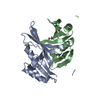
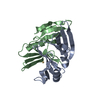

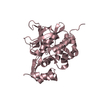
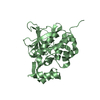


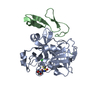


 PDBj
PDBj